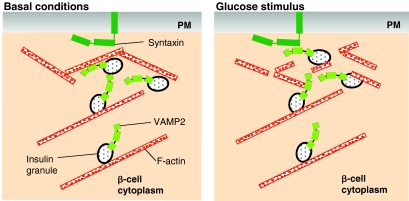Fig. 2.
F-actin reorganization, granule mobilization and glucose-stimulated insulin secretion. Under basal conditions (left panel), F-actin not only functions as a barrier to block SNARE-complex formation, but also supplies transportation tracks for insulin-containing granules. Glucose stimulation (right panel) triggers transient F-actin reorganization to allow the granules access to the plasma membrane (PM) for subsequent docking, fusion (mediated by interactions between VAMP2 and syntaxins) and insulin release.

